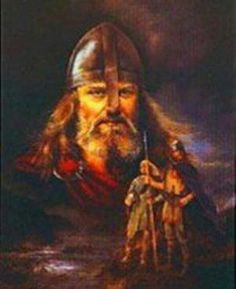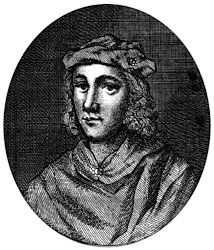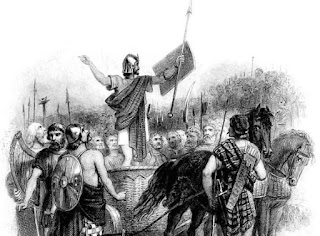Vikings
Viking Legacy
Some parts of Scotland conquered by the Vikings, in the 9th century, belonged to Norway for hundreds of years.
The Western Isles were Norwegian until 1266.
Orkney and Shetland only returned to Scotland in 1469, and retain a strong connection to their Viking past.
We can read the epic story of the Earls of Orkney, the Orkneyinga Saga, written down in Iceland around 1200.
Many of the Viking settlers in Iceland were from Scotland, and took the stories with them. The carving below is based on an Icelandic epic called the Saga of the Volsungs. It tells the story of Sigurd, Dragon Slayer, and shows the making of a sword.
Many Scottish islands like Colonsay, Oronsay, Ulva and Uist have Norse names. The island of Cumbrae in the Clyde is half Norse, half Welsh. From cumbr, Welsh for Britons, and ae, Norse for island. So Cumbrae means island of the Britons. All the Scottish firths, like the Firth of Forth or Clyde, are Scots derivations of the Norse fjord. Sutherland, despite being in the far north of Scotland, means the southern land. Vikings called it that because it lay south of Orkney.
Towns, too, bear the imprint, of the Vikings. Helmsdale, Stornoway, Armadale have Norse names. Thurso is Norse for the river of the ox. Kirkwall means the church field. And Ullapool means the pool of Ull, who was a Norse pagan god.
In the mid-12th century, Vikings looking for treasure broke into Maes Howe, an Orcadian Stone Age burial cairn. They found nothing, but they carved messages on the walls in runes ( the Viking alphabet).
One of them, perhaps the Icelander Thorhall Asgrimsson, left this poetic message:
' The man who is most skilled in runes west of the ocean cut
these runes with the axe once owned by Gauk son
of Trandil in the south country '
This whalebone plaque found at the Scar boat burial site at Sanday, Orkney, is the finest object of its kind to have been discovered anywhere in the Viking world.
It was probably made in Northern Norway and might have been used for pressing pleats or small linen items, such as a cap. It lay with the body of a woman alongside a gilded bronze brooch and objects used for spinning, sewing, and weaving.
Who was he, this wealthy Viking warrior buried with his sword on the island of Eigg more than 11 centuries ago? Svein? Hakon? Thorbjorn? We shall never know, but the exquisitely-made hilt of his precious word tells us volumes about this Norwegian raider-turned-settler.
His mounded grave had lain untouched until around 1830, when crofter Allan Mackay levelled it for cultivation. Mackay found the remains of the sword in its scabbard, together with a decorative bronze fitting from a stave-built wooden bucket and a whetstone.He kept the sword blade fragments and the whetstone, and they are now lost, but luckily the bucket mount and sword hilt were presented to the National collections in Edinburgh. Today they are proudly displayed in the Early People galleries of the Museum of Scotland.
The sword was a masterpiece of the metalworker's craft. The iron blade would have been made by an expert smith and may have been imported into Norway. The hilt, probably made in Norway, is of cast brass. Riveted to it are panels of silver and a black substance called niello, and thin silver wires run around the edges. The panels are decorated with fanciful beasts, their heads turned back.
X-rays showed it started life as four hollow interconnecting pieces, held together by the upper end of the sword blade. Sand was used to fill the gaps and give it weight. Whether it would have worked well as a practical weapon, we're not sure. But it certainly fulfilled its purpose of showing off the wealth, power and good taste of its owner.















Comments
Post a Comment